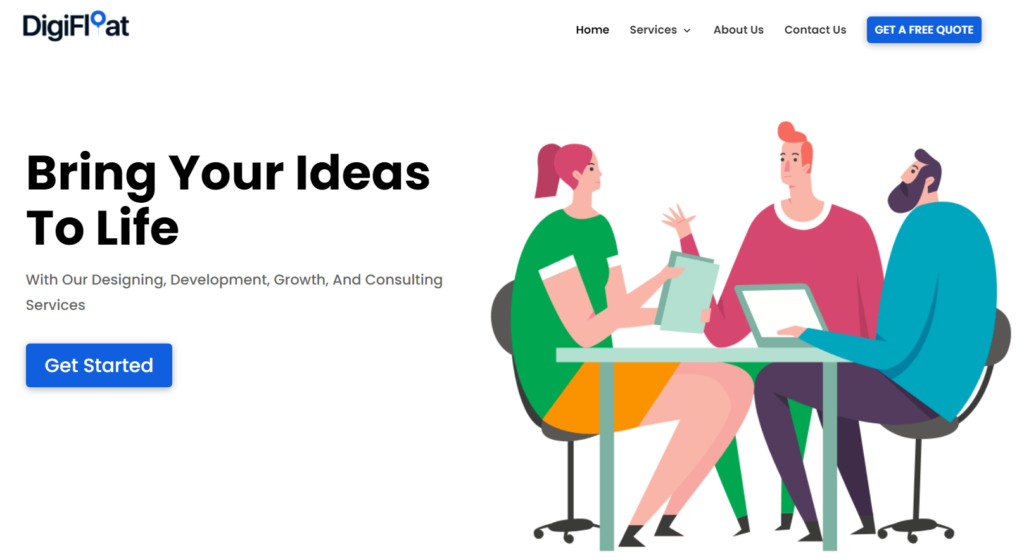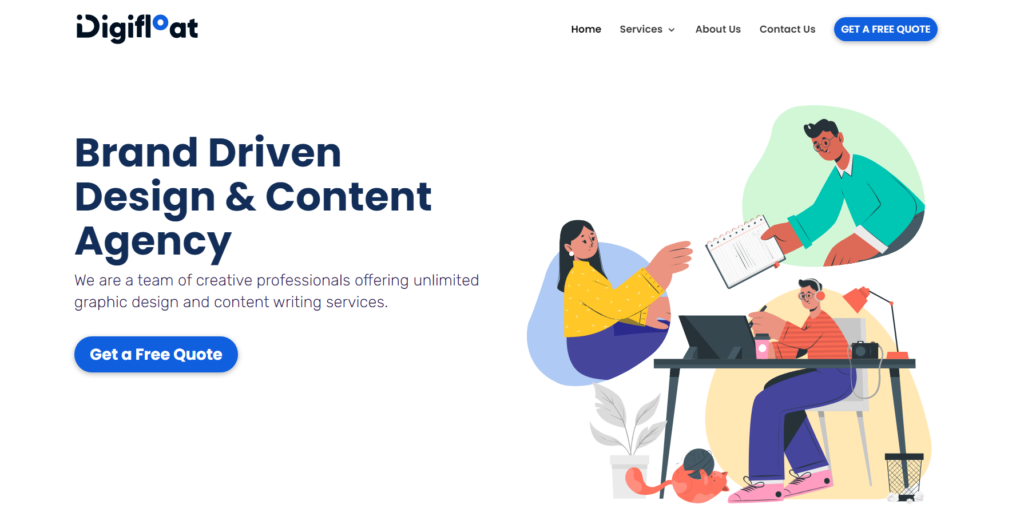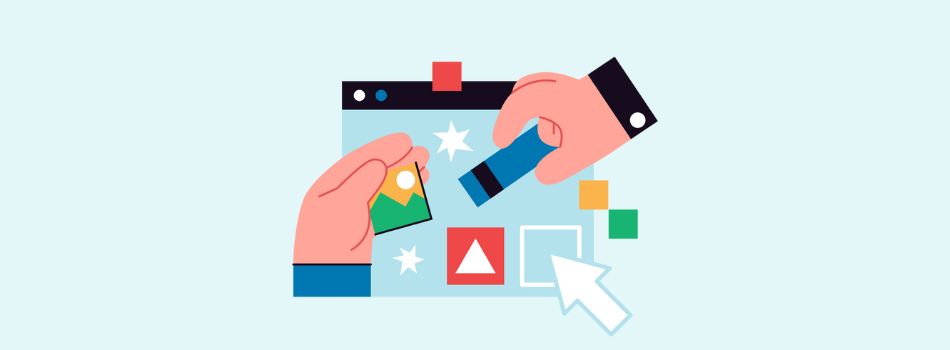Do you think it’s time to rebrand? If so, what is your rebranding strategy?
It sure cannot be, let’s get a new website!
You’ll need a strategy in which you can identify a good reason to rebrand, your target audience, your brand’s positioning, marketing, etc.
Also, you have to figure out if you want a partial rebrand or a complete makeover.
For our company, Digifloat, we did a complete rebranding. Even though our name and domain remained the same, everything else from our logo to our website and social media presence got an upgrade.
The journey wasn’t easy, but I feel we did great because we made a rebranding strategy and clung to it.
I am writing this blog post to tell you everything about our rebranding and new website. Our strategy, reasoning, ideas, design, and development process, and the costs involved.
Let’s get started…
The Rebranding Strategy
- Who Are We?
- Why Do We Need to Rebrand?
- How Are We Getting New Designs?
- Preparations
- Old vs New
- Getting Ready for Launch
- Our Mistakes
- Should You Get a Rebrand?
1. Who are we?
I feel I should tell a little about who we are, so you can understand what we do, who are our target customers, and why we really needed this rebranding.
At Digifloat, we offer unlimited graphic design and content writing services. The company was launched in 2019, so we are comparatively new. Today, we are a team of 10+ creative nerds with 20+ clients.
Our target audience consists of small business owners and startups who are looking to delegate design, development, and content writing tasks at affordable prices.
2. Why Do We Need to Rebrand?
We couldn’t just get a rebrand because everyone else is doing it. We had good reasons for getting a rebrand and a new website.
Why Rebranding?
A. Expanding our Product Offering
When we started out, we were offering design and development services only. Later, we expanded to include growth services like social media marketing and content writing. We just kept adding new services and new pages to our website.
In short, we were all over the place. Our site structure was a mess. We needed to organize our content and improve our website’s usability.
B. Unprofessional Logo
Our first logo was designed in a hurry. It wasn’t bad, but it had a lot of design problems.
Firstly, the logo was not at all scalable, and the font didn’t correlate with the rest of the website. It wasn’t tailored for our brand. We wanted to upgrade and fix these issues.
Why Redesign the Website?
A. Improve Our Face Value
When we first designed our brand, we didn’t take too much professional help. Jaideep (the owner of the company) did most of the work himself. At first, it was good enough. We were a small startup, and getting a good website up and running was enough for us.
But now that we have a good number of website visitors to whom we are offering design services, our own designs have to look good too.
B. Low Conversion Rate
Now, this could be because of multiple reasons. But the one reason we figured out, after a lot of website visitor analysis (thanks to Hotjar), was that our website structure was too complicated.
This happened because we were blindly adding pages. And even our website’s content wasn’t as clear as it should have been. We weren’t answering the basic questions like who we are and what we do on our website. This had to change.
C. User’s Feedback
This was one of the biggest reasons that pushed us towards rebranding. As our website’s traffic increased, so did our leads. We were getting leads from our live chats and contact us pages.
These people were interested in our services, but they couldn’t find answers to simple questions. Most commonly, we get one question: “Where can I see your design portfolio?”.
We did have our portfolio on our service page, but for some reason, it wasn’t recognizable. We wanted to fix this.
3. How Are We Getting New Designs?
The very first step was to find the right people for this job. Luckily, we found everyone in-house.
We have the designers and we have the writers. We have people who know a thing or two about branding.
But even if the people work in-house, they still get paid. The time they spent rebranding Digifloat would be spent on clients’ work.
So if we calculate by hours, it costs us exactly what we are charging for our pro plans, i.e., $649/mo.
In this plan, we offer a dedicated designer and a client manager, unlimited graphic designs, web & app UI/UX design, HTML/CSS/JS page creation, and WordPress.
4. Preparations
This step was solely dedicated to finding inspiration. We do want a unique brand presence, but we cannot rely solely on our brains for ideas.
Me and Jaideep took our time to browse through Dribbble, Behance, OnePageLove, Lapa.Ninja, and every other design inspiration website on the internet.
We found so much stuff! So many things we loved that we spent more time shortlisting than actually looking for them.
After about a week of full-blown research, we had an idea of what we wanted.
And then we got to work…
5. Old vs New
I am dividing everything into sections, so I can talk about our rebranding strategy for every part. This is what I have covered:
A. Website Content
B. Logo Redesign
C. Page Designs
D. Web Development
A. Website Content
Before designing, we wanted to rewrite the content of our website. After doing good research, we concluded that not all our pages needed content upgrades.
Our main focus was on the homepage. This is what it looked like before:

The heading and the subheading were so vague. Even our CTA was weak.
So we started rewriting the website’s content. We took a lot of lessons from Julian Shapiro before getting started.
Some aspects we had in our mind while rewriting include:
- Avoid unnecessary jargon and slang.
- Refocus the content on one topic or one audience per page.
- Stick to our brand standards for messaging and tone of voice.
- Prioritize users’ intent.
- Make your CTA shine.
- Find cross-linking opportunities for every page.
This is something we came up with for our homepage:

Click here to see our entire homepage.
We are quite happy with this. The homepage now answers what we do, who we work for, and it has clear CTAs.
Similarly, we rewrote a lot of our website’s content.
Then came the design part. We wanted to complete all the designs first before going to the development stage. So we started with our logo…
B. Logo Redesign
It isn’t necessary to tell you about the importance of a brand’s logo.
But our previous logo had a bunch of problems (as I was told by our designers).
- Loose Elements – We had dotted elements in our emblem, and the O of our Digifloat was actually a balloon. The string of that balloon was not visible once we scaled our logo. Also, both our emblem and logo had special elements that conflicted with each other.
- Non-Specific Font – The font of our logo didn’t correlate with what we were using throughout our website. It also wasn’t something that would stand out from our competitors.
This is how our old logo looked like:

Now with the new logo, we wanted to retain the original color scheme. We also didn’t want to completely change it. I know we aren’t a big brand that our reputation might get hurt with this, but there was just an emotional attachment here.
We started the company with this small idea, and we didn’t want to completely lose that element.
So this is what our designers came up with:

And we love it ❤️
There are no loose elements here, and the font suits our brand. It’s a simple, readable, yet modern logo.
C. Page Designs
There are going to be a lot of parts in this one…
Firstly, our previous website had illustrations all over with some waves and colored backgrounds like these:

This was some gradient effect that we tried here.
This time, we wanted a cleaner website. A few things we laid out for our designers:
I. Use illustrations
We have a special love for our illustrations. Earlier, we didn’t customize any and used the readily available ones from UnDraw and Whoosh.
These were completely different from each other. So every page on our website had a different kind of illustration. Ugh!
This time around, we wanted customized illustrations that all look similar throughout the website.
II. No colored backgrounds
From the time we spent looking for inspiration, we found ourselves particularly attracted to clean, minimalist designs. We wanted similar clean backgrounds that wouldn’t distract from our content.
D. Page Development
We have an in-house web development team, and they are really good. All the pages were developed on WordPress with the Divi theme, and it took us around a month to get this finished.
All these tasks took a bit longer than expected since we dedicated the time of our internal teams to this project. We had to balance our own work and our clients’ projects. But in a few months, we were ready for the launch….
6. Getting Ready for Launch
Once everything was ready to go, we made a launch plan. Even though we don’t get crazy traffic, we still needed to cover our bases. We didn’t want to ruin what we made in the last 2 years.
One of the things we were most worried about was our SEO. It is our strongest game as we get most of our traffic from organic searches. And now we were making changes to our entire site structure, so we had to try our best to avoid 404s and other issues.
Here’s a small checklist we made before going live:
- Make sure the website copy is accurate and error-free
- Replace all placeholder images with final images
- Test design on various devices
- Review browser compatibility
- Create a site backup
- Audit the technical SEO for errors
- Make sure all internal and external links are working properly
- Check if integrations with third-party tools are running smoothly
- Update all social share images
- Allow search engine indexing
7. Our Mistakes
Our rebranding strategy wasn’t perfect. We made a lot of mistakes along the way. I’m sharing these with you so you don’t:
A. Too many inspirations
We spent a lot of time finding inspiration, and we ended up loving it so much. There are so many great websites out there.
It was hard to narrow down our options later. We even confused our designers a lot.
I would highly recommend just sticking to one or 2 websites like Dribbble and Behance and that’s it. See what you love here and don’t shop too much.
B. Unrealistic time frame
We made this rebranding strategy in August and planned to finish everything by the end of September. 2 months would be a lot for any other brand or even for our clients. This was a reasonable time frame.
But we didn’t have designers and developers dedicated specifically to this task. We were multitasking. Hence, we needed more time for this project.
We didn’t take this into account. We were able to finish this project by the end of October. This delay gave us so much stress.
Now the big question…
8. Should you get a rebrand?
Rebrands can be a nightmare if not done properly. You need to properly analyze your situation and current problems before getting started.
There may be a chance that you don’t need a rebrand at all. If you face problems with your sales, you might need a new marketing strategy and not a rebranding strategy.
But if you feel your company’s ideologies are no longer reflected in your brand, then you can go ahead with a rebrand.
Here are a few reasons you might need a rebrand if:
- You have merged or acquired a new company.
- You expanded your product offering.
- You repositioned your brand to target a completely new customer profile.
- Your branding no longer represents who you are as a professional.
- You aren’t able to attract the right people to your brand.
Here are a few reasons you might not need a rebrand if:
- You are getting bored with seeing the same designs every day.
- You have an internal issue and not a market issue.
- You don’t have the resources or money for this project.
In the end, if you have determined a rebrand is the right choice for you, get started with a rebranding strategy.
Hire our team of professional designers and get unlimited graphic designs at $399/month.



